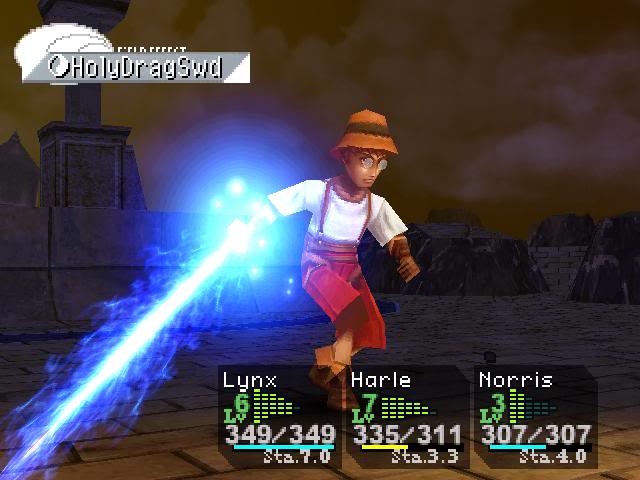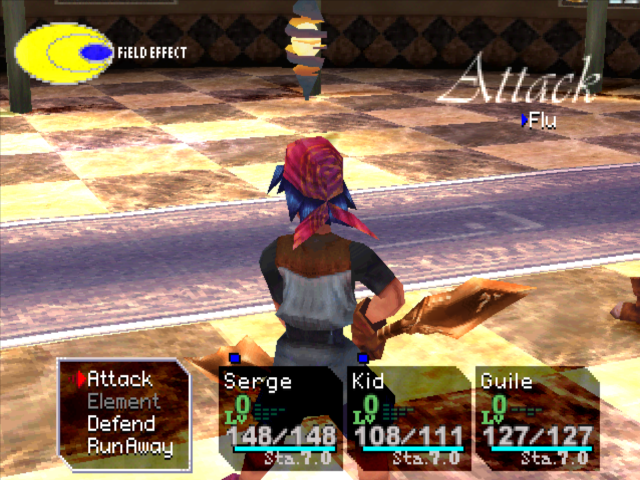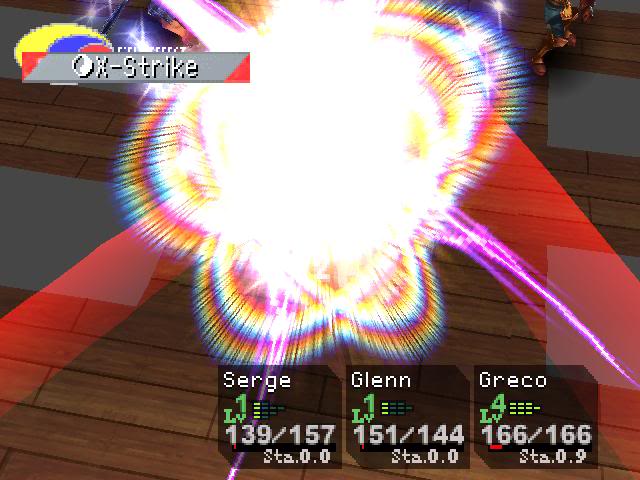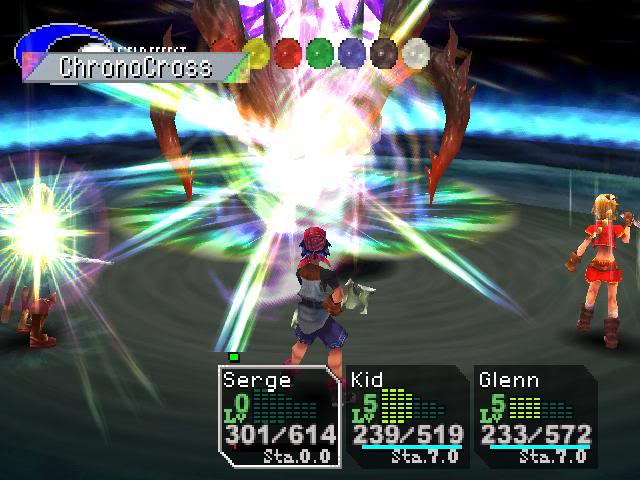In this final article on Chrono Cross combat mechanics I want to touch on various Element effects that aren’t related to directly dealing damage or healing. With such a large mechanical “surface area” there are numerous opportunities to design situationally useful abilities that let the player and the AI manipulate the flow of battle.
Part 5: Odds & Ends
1. Color Manipulation
Among the Elements on offer are one for each of the six colors that can
- Turn the whole Field Effect to that color immediately, setting up a summon Element or simply turning the color bonus in your favor (e.g. RedField);
- Temporarily change the innate color of an ally or enemy to make the matchup more or less effective for dealing damage (e.g. TurnRed);
- Or block the character from using Elements of a certain color – like the standard RPG status effect “Silence” but restricted to a particular subset of magic (e.g. AntiRed).
Interestingly, the Anti– series of Elements can only be equipped by characters of the opposite color, who would be most vulnerable to damage from that color of attack.

This is a traumatizing image for Chrono Cross players. Should have used BlackField before this could happen! Image via lparchive.org
2. Buffs
There are the usual temporary stat increases and decreases; each color is associated with one stat (Red/Attack, Yellow/Defense, Black/Magic Attack, White/Magic Defense, Green/Accuracy, Blue/Evasion). Then there are two buffs that specifically interact with the unique systems of CC: Ninety-Nine, which temporarily makes a character’s Hit% the maximum value of 99% for every level of attack, and Vigora, which temporarily reduces a character’s stamina cost for all actions to 0. (Because it doesn’t quite fit in any other category, I’ll also mention Recharge here, which makes one previously used Element available again in the current battle.) These are straightforward effects that remove limitations placed on the player by the combat system, highlighting how significant those limitations are.
3. Status Effects
Unusually for an RPG, it’s not possible (for the player, at least) to deliberately inflict specific status effects on enemies. Instead, status effects are a secondary consequence of taking damage of a certain color. Each color is associated with two status effects that may be inflicted when a character is attacked with Element of that color.
- Red: Burns (reduced defense) and Confusion (character acts independent of player input, may attack allies)
- Blue: Flu (reduced stamina recovery) and Frozen (cannot act; game is over if all party members are Frozen)
- Green: Poison (HP decrease each time anyone acts – this can take your HP to 0!) and Afraid (more likely to receive critical attacks)
- Yellow: Sprain (reduced attack) and Dizzy (reduced evasion)
- White: Asleep (cannot act but no game over condition) and Fatigued (increase stamina costs)
- Black: Cursed (lose stamina when taking damage) and Darkness (reduced accuracy)

In my current playthrough I was stuck in Viper Manor with no blue status-healing Elements and two party members hit with Flu. Having reduced stamina recovery in battle is less than ideal; being unable to point your character in a specific direction on the map, for instance to open several unskippable doors, is controller-snappingly awful.
The statuses that relate to stamina aren’t relevant to enemies since they don’t use stamina; it’s conceivable that some analogous effect could be applied to how often they act or how much they can do in one turn, but like everything about enemy actions in CC, if that does happen it’s totally opaque.
Among the status effects, four last indefinitely – and also cause detrimental effects outside of combat – until a status-healing element of the corresponding color is used: Burns (extra damage from environmental traps), Flu (causes player to be unable to move in a straight line outside of battle (INFURIATING)), Poison (lose HP as you move), and Sprain (unable to run).
4. Techs
Each of the 45 playable characters has three unique abilities or “Techs” permanently equipped in their Element Grid, at levels 3, 5 and 7. The level 7 Tech is unlocked after a late-game quest for that character (usually the only character development anyone gets after they’re recruited). Like normal Elements, most Techs are just different ways of dealing damage, but there are a few specialties worth noting.
- Kid’s Pilfer, Mel’s Snatch and Fargo’s Pillage are the only means of stealing items from enemies, meaning I keep as many of them in my party as possible.
- Riddel’s SnakeFangs and Leena’s MaidenHeart can randomly recharge multiple used Elements.
- Luccia’s Mix&Match inflicts random status effects without dealing damage.
- Sprigg’s Doppelgang replaces her with an enemy you’ve fought before.
- Van’s WetPaint fills the Field Effect with random colors.
Very rarely, two characters will be able to perform a Cross Tech if they both have enough stamina & Element Power to perform the same level Tech. This is a nod to Chrono Trigger where this mechanic was much more essential; it’s easy to miss these combinations entirely in Chrono Cross, and a lot of Trigger fans were upset that Cross more or less ditched its predecessor’s most distinguishing combat feature.

Serge and Glenn have one of Chrono Cross’ nine “Cross Techs;” this one is a reference to Crono and Frog’s combo attack in Chrono Trigger. Image via lparchive.org
5. Trap Elements
Certain shops available midway through the story allow you to buy Trap Elements that correspond to certain Elements that enemies can cast. If you cast a Trap during a battle and an enemy casts the targeted Element later in that battle, their Element is canceled and your Trap turns into a copy of the Element. This is the only way to obtain summon Elements, and only a handful of Elements overall have Traps. It’s an interesting idea, sort of, but totally inessential – except, as noted previously, if you need to use summons to grind for Shiny materials. Like summons overall, this is extremely goofy.
6. ChronoCross (spoilers for the endgame!)
I couldn’t end this series without talking about the very interesting Element that shares its name with the game itself. Available only just before the final battle, the “7th color” Element ChronoCross does two things:
- Recharge all used Elements
- Unlock the true ending if used correctly against the final boss
One of my favorite gimmicks in games is a final boss that requires you to apply your mastery of the game’s mechanics in order to achieve a totally different goal. A great example of this is Phoenix Wright: Justice For All, in which you must use evidence to find contradictions in witness testimony not to expose the truth – you know the witness isn’t lying – but to stall for time during a hostage situation.
Killing Chrono Cross’ final boss is moderately difficult, just because it has so much HP, but you’re not actually supposed to kill it. Instead, you have to arrange for a specific sequence of seven colors to be cast, ending with ChronoCross. The sequence is hinted at through visual and musical cues throughout the final dungeon; once you have Chr– I’m going to stop doing that now – once you have ChronoCross, each Element used in battle produces a note from the seven-note melody you must eventually “perform” for the final boss.
The problem is that the boss actively interferes with this process, by casting the opposite color Element from whatever is supposed to happen next in the sequence. Furthermore, it’s not mathematically possible for the party to cast all seven Elements without running out of stamina and allowing the boss its turn: even starting from 7.0 stamina for everybody, you can only get six Elements out before all three characters go negative. So the trick is to incorporate the boss’ turn into the sequence, by arranging for its turn to happen when the correct next color is green, forcing it to use yellow, the correct first color of a new sequence.

You only get the true ending if you use ChronoCross after a sequence of Elements Yellow-Red-Green-Blue-Black-White. Making that happen is very hard unless you’ve mastered the math behind Chrono Cross’ stamina system. Image via lparchive.org
Pulling this off requires preparation on the player’s party, i.e. equipping low-level Elements of many colors on all characters so that the sequence can be performed using the minimum Element Power. It also requires detailed knowledge of the math that drives the stamina system and how many consecutive actions the party can perform. Finally it requires the player to recognize the pattern in the boss’ actions and figure out how that predictable pattern can be used to their advantage. It’s a little bit obtuse, yes, but also absolutely brilliant. Sort of like the whole game.
I hope you’ve found this series enjoyable and informative. Chrono Cross is one of my favorite games and I discovered a lot of things I didn’t know about it while writing these articles. What I learned about how the game works, and the strengths and weaknesses of its mechanics, will inform how I adjust and balance the combat system in my own game. Stay tuned here and on my Twitter for news about that game, which I’ll be ready to announce in the coming months. Thanks for reading!
